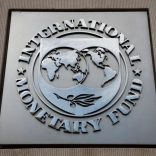Brazil’s president asks US to scrap tariffs in ‘friendly’ call with Trump
Angola: IMF expects economic growth of 3.5% this year, 3.7% in 2024

File photo: Lusa
The International Monetary Fund(IMF) expects the Angolan economy to accelerate this year to 3.5% and to grow by 3.7% in2024, with inflation falling from 21.4% in 2022 to 11.7% this year.
In the report on sub-Saharan Africa, published on Friday as part of the Annual Meetings of the IMF and World Bank, held this week in Washington, the Fund presents several macroeconomic projections for countries in the region, predicting that Angola will see a significant drop in consumer prices, which will fall from 21.4% last year to 11.7% this year and 10.8% on average next year.
In terms of public debt, the IMF anticipates a reduction in the ratio of this indicator to GDP, forecasting that it will improve from 67%, in 2022, to 63.3% this year and 59.2% in 2024, after having reached a peak of 138.9% in 2020, in a context of devaluation of the kwanza and economic recession caused mainly by the pandemic and by a reduction in international oil prices.
The IMF argues that sub-Saharan African countries should improve financial management, contain inflation, allow for exchange rate adjustments and ensure that climate change does not take money away from basic spending.
In the report on the region, released today as part of the IMF and World Bank Annual Meetings taking place this week in Washington, the Fund lists four priorities for African governments to try to overcome macroeconomic imbalances in a context of financing constraints.
“Consolidating public finances and strengthening public financial management in a context of difficult financing conditions will depend on continued resource mobilisation, better management of fiscal risks and debt management that needs to be more proactive,” write the Fund’s experts in the report, which forecasts growth of 3.6% for sub-Saharan Africa this year and 4.2% in 2024, and which is entitled ‘The Big Financing Gap’.
The second of the four priorities has to do with inflation, which rose to 10% last year and is expected to slow to about half that this year: ‘Monetary policy needs to be cautiously directed until inflation is firmly on a downward path and in line with central bank targets,’ the report reads.
Allowing the exchange rate to float, while mitigating adverse effects on the economy, “including rising inflation and debt due to currency depreciations” is the third priority task for governments in sub-Saharan Africa, a region where the IMF has more than 20 financial assistance programmes underway, almost half of the total for the region’s 54 countries.
Climate finance is the last of the priority areas for action, in which the IMF argues that “climate change and financing to combat and mitigate it should not take spending away from basic needs”, exemplifying with health and education.
COUNTRY ……………………GDP…………INFLATION…………..DEBT/GDP RATIO
Angola…………………………..3.5…………………11.7………………………..63.3
Cape Verde……………………4,4………………….4,5……………………….120,2
Guinea-Bissau……………….4,5………………….5,0………………………..76,5
Equatorial Guinea………….-1,8…………………5,7………………………..26,4
Mozambique…………………..5,0………………..7,4………………………..102,8
São Tomé and Príncipe……2.0………………..17.9………………………..54.8
Region average……………….3.6………………..14.0………………………..55.5
Source: Sub-Saharan Africa Regional Economic Outlook, April 2023.












Leave a Reply
Be the First to Comment!
You must be logged in to post a comment.
You must be logged in to post a comment.